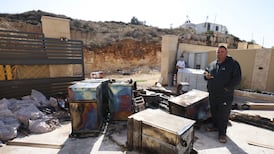A controversial US-backed aid group proposed building camps called “Humanitarian Transit Areas” inside – and possibly outside – Gaza to house the Palestinian population, according to a proposal reviewed by Reuters news agency, outlining its vision of “replacing Hamas’ control over the population in Gaza”.
The $2 billion (€1.7 billion) plan, created sometime after February 11th for the US-backed Gaza Humanitarian Foundation (GHF), was submitted to the Trump administration and recently discussed in the White House, according to a source familiar with the matter.
The plan describes the camps as “large-scale” and “voluntary” places where the Gazan population could “temporarily reside, deradicalize, re-integrate and prepare to relocate if they wish to do so”.
The Washington Post referred to GHF plans to build housing compounds for Palestinian non-combatants in May. A slide deck seen by Reuters goes into granular detail on the transit zones, including how they would be implemented and what they would cost.
RM Block
It calls for using the sprawling facilities to “gain trust with the local population” and to facilitate US president Donald Trump’s “vision for Gaza”.
It was not possible to independently determine the status of the plan, who submitted it, or whether it is still under consideration.
The aid group, responding to questions, denied that it had submitted a proposal and said the slides “are not a GHF document”.
Gaza Humanitarian Foundation said it had studied “a range of theoretical options to safely deliver aid in Gaza,” but that it “is not planning for or implementing Humanitarian Transit Areas”,
Rather, the organisation said it is solely focused on food distribution in Gaza.
A spokesperson for SRS, a for-profit contracting company that works with Gaza Humanitarian Foundation, said “we have had no discussions with GHF about HTAs [Humanitarian Transit Areas] and our ‘next phase’ is feeding more people. Any suggestion otherwise is entirely false and misrepresents the scope of our operations.”
The document included the Gaza Humanitarian Foundation name on the cover and SRS on several slides.
On February 4th, Mr Trump first publicly said that the US should “take over” the war-battered enclave and rebuild it as “the Riviera of the Middle East” after resettling the population of 2.3 million Palestinians elsewhere.
Mr Trump’s comments angered many Palestinians and humanitarian groups about the possible forced relocation from Gaza. Even if the Gaza Humanitarian Foundation proposal is no longer under consideration, the idea of moving a large portion of the population into camps will only deepen such worries, said several humanitarian experts.
The White House did not respond to a request for comment.
The proposal was laid out in a slide presentation that a source said was submitted to the US embassy in Jerusalem earlier this year.
The US state department declined to comment. A senior administration official said, “nothing of the like is under consideration. Also, no resources are being directed to that end in any way.” The source working on the project said that it had not moved forward due to a lack of funds.
The Israeli embassy in the US did not respond to a request for comment. Ismail Al-Thawabta, director of the Hamas-run Gaza Government media office, said it “categorically” rejects the GHF, calling it “not a relief organisation but rather an intelligence and security tool affiliated with the Israeli occupation, operating under a false humanitarian guise”.
The undated slide presentation, which includes photographs dated February 11th, said that the Gaza Humanitarian Foundation is “working to secure” more than $2 billion for the project, to “build, secure and oversee large-scale Humanitarian Transit Areas (HTAs) inside and potentially outside Gaza strip for the population to reside while Gaza is demilitarized and rebuilt”.
The transit areas described in the slides would be the next phase in an operation that began with Gaza Humanitarian Foundation opening food distribution sites in the enclave in late May, according to two sources involved in the project.
GHF co-ordinates with the Israeli military and uses private US security and logistics companies to get food aid into Gaza. It is favoured by the Trump administration and Israel to carry out humanitarian efforts in Gaza as opposed to the UN-led system, which it says lets militants divert aid.
Hamas denies this and says Israel is using hunger as a weapon.
The United Nations has called Gaza Humanitarian Foundation’s operation “inherently unsafe” and a violation of humanitarian impartiality rules. The UN human rights office says it has recorded at least 613 killings at foundation aid points and near humanitarian convoys run by other relief groups, including the UN.
The proposal did not specify how the Palestinians would be relocated into the camps, or where the camps could be built outside Gaza, but a map shows arrows pointing to Egypt and Cyprus as well as other points labelled “Additional Destination?”
GHF would “oversee and regulate all civil activities required for construction, deradicalisation and temporary voluntary relocation”, stated the proposal.
“There is no such thing as voluntary displacement amongst a population that has been under constant bombardment for nearly two years and has been cut off from essential aid,” said Jeremy Konyndyk, president of the Refugees International advocacy group and a former senior US Agency for International Development official who reviewed the plan.
The source who worked on planning for the camps said the intent “is to take the fear factor away”, enabling Palestinians to “escape control of Hamas” and providing them with “a safe area to house their families.”
The latest bloodshed in the decades-old Israeli-Palestinian conflict was triggered on October 7th, 2023, when Hamas attacked southern Israel, killing about 1,200 people and taking 251 hostages, according to Israeli tallies. Gaza’s health ministry says Israel’s retaliatory military assault on the enclave has killed more than 57,000 Palestinians, caused a hunger crisis, and displaced nearly Gaza’s entire population internally. – Reuters



















